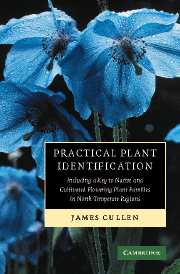 Practical Plant Identification
Practical Plant Identification Book contents
- Frontmatter
- Contents
- List of illustrations
- Preface
- Acknowledgements
- Introduction
- Examining the plant: a brief survey of plant structure and its associated terminology
- Using the keys
- Keys
- ‘Spot’ characters
- Arrangement and description of families
- Further identification and annotated bibliography
- Glossary
- Index
Examining the plant: a brief survey of plant structure and its associated terminology
Published online by Cambridge University Press: 02 December 2009
- Frontmatter
- Contents
- List of illustrations
- Preface
- Acknowledgements
- Introduction
- Examining the plant: a brief survey of plant structure and its associated terminology
- Using the keys
- Keys
- ‘Spot’ characters
- Arrangement and description of families
- Further identification and annotated bibliography
- Glossary
- Index
Summary
The identification of plants is carried out on the basis of the information available about the plant in each particular case. In most situations this information will be derived from a specimen of the plant itself, either whole (if the plant is small, or if it is being examined in situ while growing) or a part (generally a stem or twig, with or without flowers or fruits), and consists of the structure displayed by the specimen (its morphology) together with other information that might be available (e.g. where the plant came from originally). On the basis of this information one can make use of the keys in this book to obtain an accurate identification of the family to which the specimen belongs. In order to do this, the specimen has to be observed carefully, so that the structure it displays, and the terminology needed to describe it, are properly understood. The rest of this chapter provides a very brief survey of flowering plant morphology in so far as it is needed for family identification. Each new term is italicised at its first appearance, and appears in the Glossary (p. 269). Further information can be found in textbooks of botany, in Bell, A. D., Plant Form, Oxford (1991), which is extremely well illustrated with fine photographs, and in other glossaries, such as Hickey and King, The Cambridge Illustrated Glossary of Botanical Terms, No. 19 in the annotated bibliography (p. 264).
- Type
- Chapter
- Information
- Practical Plant IdentificationIncluding a Key to Native and Cultivated Flowering Plants in North Temperate Regions, pp. 5 - 50Publisher: Cambridge University PressPrint publication year: 2006


